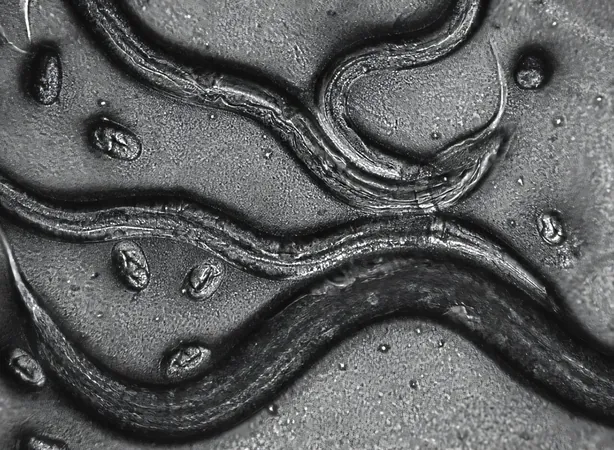
The Surprising Dual Role of CED-9: How a Cell Protector Turns into a Killer in Apoptosis Research
2024-11-19
Author: William
Introduction
Cell death is an essential process from the moment life begins until our final days; however, not all forms of cell death are beneficial. A critical process known as apoptosis helps maintain cellular balance, ensuring that the body does not accumulate excessive cells, potentially leading to conditions like cancer or autoimmune diseases. Conversely, improper apoptosis can result in harmful outcomes, contributing to various neurodegenerative disorders.
Research at MIT's McGovern Institute
At the forefront of this research are scientists from MIT's McGovern Institute for Brain Research, who have been investigating the microscopic roundworm Caenorhabditis elegans, renowned for having contributed significantly to our understanding of cellular processes and even receiving its fourth Nobel Prize last month. Their findings, recently published in Science Advances, challenge previously established paradigms about apoptosis, highlighting the dual capabilities of the protein CED-9.
Led by Robert Horvitz, who previously shared a Nobel Prize for his work on cell death in C. elegans, the team has uncovered how CED-9, typically viewed as a protector against cell death, may also promote apoptosis. This groundbreaking study comes as a revelation that underscores the complexity and importance of apoptosis in health and disease.
Breaking Down Apoptosis Mechanisms
In most multicellular organisms, including humans, a variety of proteins regulate apoptosis. However, C. elegans operates with a much simpler system, relying on just a handful of proteins to manage the cell death process. When there is an imbalance—either too few or too many cells undergoing apoptosis—researchers observe significant physiological changes. For example, excessive cell death can impair reproduction or even lead to early embryonic death.
The lab's research trajectory has led to significant insights into apoptosis control, identifying which genes and proteins govern this intricate process. The lessons learned from these worms often parallel human cellular mechanisms, providing valuable clues about potential therapeutic targets for various diseases.
CED-9: The Janus-faced Protein
Usually considered a safe-guarding factor, the protein CED-9 has shown surprising versatility in its roles. The traditional belief held that CED-9's primary function was to block apoptosis-promoting proteins. Recent findings suggest that mutations in the ced-9 gene may alternatively hinder or enhance the process of cell death.
The work revealed that while CED-9 is critical for cell survival, its dual role complicates the narrative. Certain mutations prevent cellular protection, leading to surplus cell death, while others can hyperactivate CED-9, resulting in insufficient apoptosis.
Intriguingly, research suggests that CED-9's engagement with the pro-apoptotic protein CED-4 is pivotal for promoting cell death. This goes against longstanding assumptions that CED-9's association with CED-4 solely functioned to inhibit apoptosis.
A Closer Look with CRISPR Technology
Graduate student Nolan Tucker utilized CRISPR gene-editing tools to probe the relationships further between CED-9 and CED-4. What he discovered was revealing: specific mutations in CED-9 allowed cells to survive but prevented them from undergoing necessary apoptosis, clarifying the critical interactions needed for both functions of CED-9.
Using advanced imaging, the team noted the variance in cellular locations of the CED-4 protein depending on the integrity of the CED-9, leading to deeper insights about the mechanics behind apoptosis.
Implications for Human Health
These findings are not merely academic; they have real-world ramifications. Researchers are connecting the dots between the regulatory pathways observed in C. elegans and those in humans, particularly focusing on the BCL-2 protein, which shares functional similarities with CED-9. BCL-2’s role in cancer illustrates the dire consequences that arise from a faulty apoptosis regulation mechanism, paving the way for new therapeutic strategies.
In short, the Horvitz team's work not only clarifies a key biological process but also opens avenues for understanding diseases linked to apoptosis dysregulation, such as cancer, autoimmune disorders, and neurodegenerative diseases. As research progresses, the intricate dance between protecting life and inducing cell death continues to reveal its depths—deepening our understanding of life itself.









 Brasil (PT)
Brasil (PT)
 Canada (EN)
Canada (EN)
 Chile (ES)
Chile (ES)
 España (ES)
España (ES)
 France (FR)
France (FR)
 Hong Kong (EN)
Hong Kong (EN)
 Italia (IT)
Italia (IT)
 日本 (JA)
日本 (JA)
 Magyarország (HU)
Magyarország (HU)
 Norge (NO)
Norge (NO)
 Polska (PL)
Polska (PL)
 Schweiz (DE)
Schweiz (DE)
 Singapore (EN)
Singapore (EN)
 Sverige (SV)
Sverige (SV)
 Suomi (FI)
Suomi (FI)
 Türkiye (TR)
Türkiye (TR)